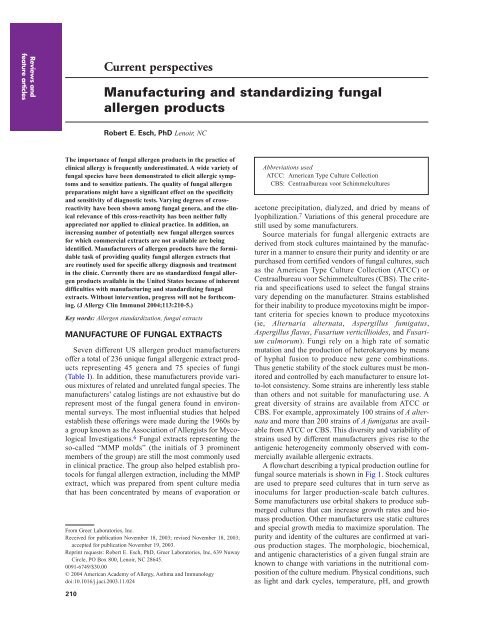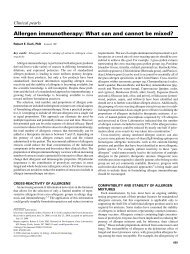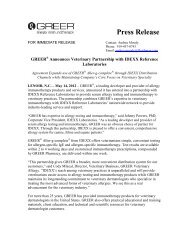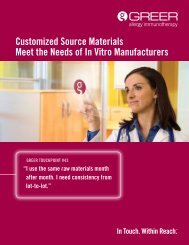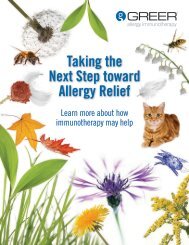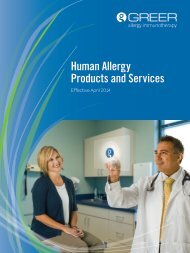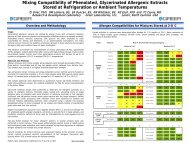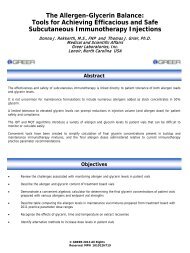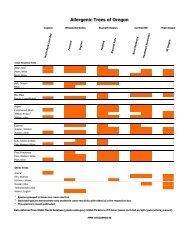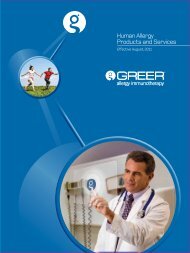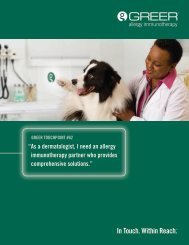Manufacturing and Standardizing Fungal Allergen Products - Greer
Manufacturing and Standardizing Fungal Allergen Products - Greer
Manufacturing and Standardizing Fungal Allergen Products - Greer
- No tags were found...
You also want an ePaper? Increase the reach of your titles
YUMPU automatically turns print PDFs into web optimized ePapers that Google loves.
Reviews <strong>and</strong>feature articlesCurrent perspectives<strong>Manufacturing</strong> <strong>and</strong> st<strong>and</strong>ardizing fungalallergen productsRobert E. Esch, PhD Lenoir, NCThe importance of fungal allergen products in the practice ofclinical allergy is frequently underestimated. A wide variety offungal species have been demonstrated to elicit allergic symptoms<strong>and</strong> to sensitize patients. The quality of fungal allergenpreparations might have a significant effect on the specificity<strong>and</strong> sensitivity of diagnostic tests. Varying degrees of crossreactivityhave been shown among fungal genera, <strong>and</strong> the clinicalrelevance of this cross-reactivity has been neither fullyappreciated nor applied to clinical practice. In addition, anincreasing number of potentially new fungal allergen sourcesfor which commercial extracts are not available are beingidentified. Manufacturers of allergen products have the formidabletask of providing quality fungal allergen extracts thatare routinely used for specific allergy diagnosis <strong>and</strong> treatmentin the clinic. Currently there are no st<strong>and</strong>ardized fungal allergenproducts available in the United States because of inherentdifficulties with manufacturing <strong>and</strong> st<strong>and</strong>ardizing fungalextracts. Without intervention, progress will not be forthcoming.(J Allergy Clin Immunol 2004;113:210-5.)Key words: <strong>Allergen</strong> st<strong>and</strong>ardization, fungal extractsMANUFACTURE OF FUNGAL EXTRACTSSeven different US allergen product manufacturersoffer a total of 236 unique fungal allergenic extract productsrepresenting 45 genera <strong>and</strong> 75 species of fungi(Table I). In addition, these manufacturers provide variousmixtures of related <strong>and</strong> unrelated fungal species. Themanufacturers’ catalog listings are not exhaustive but dorepresent most of the fungal genera found in environmentalsurveys. The most influential studies that helpedestablish these offerings were made during the 1960s bya group known as the Association of Allergists for MycologicalInvestigations. 6 <strong>Fungal</strong> extracts representing theso-called “MMP molds” (the initials of 3 prominentmembers of the group) are still the most commonly usedin clinical practice. The group also helped establish protocolsfor fungal allergen extraction, including the MMPextract, which was prepared from spent culture mediathat has been concentrated by means of evaporation orFrom <strong>Greer</strong> Laboratories, Inc.Received for publication November 18, 2003; revised November 18, 2003;accepted for publication November 19, 2003.Reprint requests: Robert E. Esch, PhD, <strong>Greer</strong> Laboratories, Inc, 639 NuwayCircle, PO Box 800, Lenoir, NC 28645.0091-6749/$30.00© 2004 American Academy of Allergy, Asthma <strong>and</strong> Immunologydoi:10.1016/j.jaci.2003.11.024210Abbreviations usedATCC: American Type Culture CollectionCBS: Centraalbureau voor Schimmelculturesacetone precipitation, dialyzed, <strong>and</strong> dried by means oflyophilization. 7 Variations of this general procedure arestill used by some manufacturers.Source materials for fungal allergenic extracts arederived from stock cultures maintained by the manufacturerin a manner to ensure their purity <strong>and</strong> identity or arepurchased from certified vendors of fungal cultures, suchas the American Type Culture Collection (ATCC) orCentraalbureau voor Schimmelcultures (CBS). The criteria<strong>and</strong> specifications used to select the fungal strainsvary depending on the manufacturer. Strains establishedfor their inability to produce mycotoxins might be importantcriteria for species known to produce mycotoxins(ie, Alternaria alternata, Aspergillus fumigatus,Aspergillus flavus, Fusarium verticillioides, <strong>and</strong> Fusariumculmorum). Fungi rely on a high rate of somaticmutation <strong>and</strong> the production of heterokaryons by meansof hyphal fusion to produce new gene combinations.Thus genetic stability of the stock cultures must be monitored<strong>and</strong> controlled by each manufacturer to ensure lotto-lotconsistency. Some strains are inherently less stablethan others <strong>and</strong> not suitable for manufacturing use. Agreat diversity of strains are available from ATCC orCBS. For example, approximately 100 strains of A alternata<strong>and</strong> more than 200 strains of A fumigatus are availablefrom ATCC or CBS. This diversity <strong>and</strong> variability ofstrains used by different manufacturers gives rise to theantigenic heterogeneity commonly observed with commerciallyavailable allergenic extracts.A flowchart describing a typical production outline forfungal source materials is shown in Fig 1. Stock culturesare used to prepare seed cultures that in turn serve asinoculums for larger production-scale batch cultures.Some manufacturers use orbital shakers to produce submergedcultures that can increase growth rates <strong>and</strong> biomassproduction. Other manufacturers use static cultures<strong>and</strong> special growth media to maximize sporulation. Thepurity <strong>and</strong> identity of the cultures are confirmed at variousproduction stages. The morphologic, biochemical,<strong>and</strong> antigenic characteristics of a given fungal strain areknown to change with variations in the nutritional compositionof the culture medium. Physical conditions, suchas light <strong>and</strong> dark cycles, temperature, pH, <strong>and</strong> growth
J ALLERGY CLIN IMMUNOLVOLUME 113, NUMBER 2Esch 211Reviews <strong>and</strong>feature articlesFIG 1. Production outline for fungal source materials. See text for details. QC, Quality control.period, might be important for sporulation <strong>and</strong> mightaffect allergen production. Because no 2 manufacturersuse the same culture medium or culture conditions, qualitativedifferences between products manufactured bydifferent companies are expected, even when identicalstrains of fungal stock cultures are used.<strong>Allergen</strong>ic materials produced by fungi during cultivationare distributed throughout the culture in the form ofspores, mycelia, <strong>and</strong> extracellular components secretedinto the growth medium. 8-11 Manufacturers might retainthe cellular (spores <strong>and</strong> mycelia), the extracellular (culturefiltrate), or the whole culture during harvest. If culturefiltrates are retained, nonantigenic culture media areused. If spores are retained, then they are rendered nonviablethrough chemical or physical means before transferto the manufacturing (extraction) facilities. Variousprocessing steps, including centrifugation, filtration,diafiltration, acetone precipitation, <strong>and</strong> lyophilization,are used to recover the allergenic materials from fungalcultures. Each manufacturer’s process requirements <strong>and</strong>specifications are unique <strong>and</strong> defined as part of theirproduct <strong>and</strong> establishment licenses.Fig 2 presents a typical production outline for fungalallergenic extracts. <strong>Fungal</strong> source materials are reconstitutedfrom the lyophilized state or extracted in an appropriatebuffer to recover the soluble allergenic materials.The allergenic potency of extracts can be influenced by anumber of variables in the extraction procedure. Themost important extraction parameters include the extractionbuffer, pH, ratio, time, <strong>and</strong> temperature. The mostcommon extraction buffer used by US manufacturers isCoca’s extraction buffer, a slightly alkaline carbonatebuffer developed to maximize protein recovery fromallergen source materials. Manufacturers might add glycerinor phenol as preservatives. Extraction ratios areexpressed as weight/volume or the weight in grams of thesource material extracted to the volume in milliliters ofextraction fluid. For example, a 1:10 wt/vol on a labeldesignates an extract that was prepared with 1 g of sourcematerial for every 10 mL of extraction fluid. Some aller-
212 Esch J ALLERGY CLIN IMMUNOLFEBRUARY 2004Reviews <strong>and</strong>feature articlesTABLE I. Commercially available fungal allergen extractsSpecies Synonym Species SynonymAcremonium stricturm Cephalosporium acrenomium Neurospora intermedia Monilia sitophilaAlternaria alternata Alternaria tenuis Nigrospora oryzaeApiospora montagnei Papularia Nigrospora sphaericaAspergillus fumigatusPaecilomyces variotiiAspergillus nigerPaecilomyces clavisporisAspergillus glaucusPenicillium notatumAspergillus terreusPenicillium chrysogenumAspergillus nidulansPenicillium digitatumAspergillus flavusPhoma betaeAureobasidium pullulans Pullularia pullulans Phoma herbarumBotrytis cinereaPhoma destructiveC<strong>and</strong>ida albicansPhycomyces blakesleenusC<strong>and</strong>ida tropicalis Pleospora herbarum Stemphylium herbarumChaetomium globosum Rhizopus oryzae Rhizopus arrhizusCladosporium herbarum Rhizopus stolonifer Rhizopus nigricansCladosporium sphaerospermum Hormodendrum hordei Rhodotorula mucilagnosa Rhodotorula rubraCladosporium cladosporoides Hormodendrum Saccharomyces cerevisiaecladosporoides Scopulariopsis brevicaulis Penicillium brevicaulisColletotrichum atramentarium Spondylocladium Sporotrichum pruinosum Chrysosporium pruinosumatramentariumStachybotrys chartarumCurvularia lunataStemphylium botryosumDrechslera specifera Curvularia specifera Stemphylium solaniEpicoccum nigrum Epicoccum purpurascens Stemphylium sarcinaeformeEpidermophyton floccosumStreptomyces griseusFusarium solaniSyncephalastrum racemosumFusarium moniliformeTetracoccosporium paxianumFusarium vasinfectum Fusarium oxysporum Trichoderma harzianum Trichoderma lignorumGeotrichum c<strong>and</strong>idumTrichophyton mentagrophytesGliocladium viride Gliocladium deliquescens Trichophyton rubrumGliocladium fimbriatumTrichophyton tonsuransHelminthosporium sativum Trichothecium roseum Cephalothecium roseumHelminthosporium solani Spondylocladium atrovirens Verticillium albo-atrumHypocrea rufaPuccinia graminis triticiMicrosporum canisUstilago maydisMucor circinelloides Mucor racemosus Ustilago cynodontis(formerly lusitanicus)Ustilago nudaMucor circinelloides Mucor mucedo Ustilago avenae(formerly circinelloides)Ustilago triticiMucor plumbeus Sphacelotheca cruenta Sporisorium cruentaMycogone perniciosagens are rapidly eluted from fungal source materials,whereas others might require homogenization, shaking,or long extraction times for maximum recovery. Thereexists a tradeoff between maximum allergen recovery<strong>and</strong> the increased release of nonallergenic substances <strong>and</strong>proteases, which might degrade some allergens. Manydifferent procedures have been devised to extract allergensfrom fungi, <strong>and</strong> no single process has been universallyadopted by the industry. 12The extract is clarified by means of centrifugation, filtration,or both through a series of filters of decreasingporosity. The supernatant or filtrate might undergo furtherprocessing, such as dialysis to remove low-molecular-weightnonallergenic material <strong>and</strong> the addition ofglycerin. The extract is rendered sterile by passing theextract through a sterilizing filter with a 0.2-µm porosity.The clarifying <strong>and</strong> sterilizing filters used must beshown not to adsorb allergens onto their surface <strong>and</strong> notto contribute any residual material into the product. Thesterile extract is quarantined until tested <strong>and</strong> released foradditional aseptic processing. Quality control testing ofthis sterile intermediate or bulk extract include tests forsterility, safety (toxicity in animals), pH, protein nitrogenunits, <strong>and</strong> preservative (phenol or glycerin). Thereleased bulk extract is aseptically diluted, mixed withother bulk products, or used without further processingto prepare stock concentrates, custom mixtures, or individualprescriptions for sale.COMPOSITION OF FUNGAL ALLERGENICEXTRACTS<strong>Fungal</strong> allergenic extracts are complex mixtures ofproteins, glycoproteins, polysaccharides, <strong>and</strong> other substances.The mean protein <strong>and</strong> carbohydrate concentrationsof selected fungal stock concentrates prepared by asingle manufacturer at 1:10 wt/vol are presented in TableII. At equivalent weight/volume concentrations, the proteincontent varied approximately 7-fold. All extractstested contained significantly higher concentrations ofcarbohydrate compared with protein, with the ratio rangingfrom about 5 to 25.
J ALLERGY CLIN IMMUNOLVOLUME 113, NUMBER 2Esch 213Reviews <strong>and</strong>feature articlesFIG 2. Production outline for fungal allergenic extracts. See text for details. QC, Quality control.TABLE II. Protein <strong>and</strong> carbohydrate content of various fungal allergen products<strong>Fungal</strong> species Protein (mg/mL) Carbohydrate (mg/mL) RatioAlternaria alternata 0.73 4.27 6Helminthosporium sativum 0.44 2.56 5Penicillium notatum 0.38 3.58 9Aspergillus fumigatus 0.28 4.16 15Cladosporium cladosporoides 0.25 6.00 24Ustilago maydis 0.10 2.38 24The protein, carbohydrate, <strong>and</strong> Alt a 1 contents <strong>and</strong> therelative potencies of A alternata products manufacturedby different companies are shown in Table III. Whenadjusted to equivalent weight/volume concentrations, theprotein <strong>and</strong> carbohydrate contents varied by more than100-fold. Similar variations in the protein <strong>and</strong> carbohydratecontents of commercially available fungal extractsderived from Penicillium notatum, A fumigatus, Epicoccumnigrum, Helminthosporium sativum, <strong>and</strong> Aureobasiumpullulans were found (data not shown). The variabili-
214 Esch J ALLERGY CLIN IMMUNOLFEBRUARY 2004Reviews <strong>and</strong>feature articlesFIG 3. SDS-PAGE profiles of commercial A alternata extracts: lane 1, molecular weight st<strong>and</strong>ards; lane 2, 1:10wt/vol <strong>Greer</strong> aqueous; lane 3, 1:20 wt/vol <strong>Greer</strong> glycerinated; lane 4, 1:10 wt/vol Hollister-Stier aqueous; lane5, 1:10 wt/vol Hollister-Stier glycerinated; lane 6, 1:20 wt/vol Allergy Labs glycerinated; lane 7, 1:10 wt/volALK glycerinated; lane 8, 1:10 wt/vol Allermed glycerinated; lane 9, 1:10 wt/vol Nelco glycerinated; lane 10,1:10 wt/vol Antigen Labs glycerinated. Samples were loaded at 0.7 µg of protein except for lanes 6 <strong>and</strong> 9,which were loaded at 0.3 µg <strong>and</strong> 0.2 µg, respectively, because of low protein content of the extracts. Componentswere visualized by means of silver staining.TABLE III. Composition of Alternaria alternata products from different manufacturersManufacturer Wt/vol Protein (mg/mL) Carbohydrate (mg/mL) Alt a 1 (µg/mL) Relative potency<strong>Greer</strong> 1:10 0.73 4.27 1.85 1.334Hollister-Stier 1:10 0.19 11.38 2.75 0.246ALK-Abello 1:10 0.03 17.14 0.04 0.281Allergy Labs 1:20 0.06 31.30 0.05 0.061Allermed 1:10 0.15 2.40 0.05 0.581Nelco Labs 1:5 0.08 33.79 2.04 0.012Antigen Labs 1:10 0.15 10.96 0.09 0.219ty in specific allergen content <strong>and</strong> ELISA inhibitionpotency of A alternata extracts from different manufacturerswas consistent with that found in previousreports. 13,14 No significant correlation (r < .5) wasobserved between the Alt 1 concentrations <strong>and</strong> the respectiveprotein, carbohydrate, <strong>and</strong> relative potency values.The compositional profiles evaluated by means ofSDS-PAGE of various A alternata products manufacturedby different companies are presented in Fig 3. Notwo company’s products yielded comparable b<strong>and</strong>ingpatterns. Similar profiles were evident between aqueous<strong>and</strong> glycerinated products manufactured by one company(lanes 2 <strong>and</strong> 3). In contrast, significant differences wereevident between aqueous <strong>and</strong> glycerinated products manufacturedby another company (lanes 4 <strong>and</strong> 5).On the basis of compositional analyses, it becomesobvious that the different manufacturers’ products arequalitatively different <strong>and</strong> that weight/volume designationsdo not reflect the relative antigen or allergenicactivities of fungal allergen products. Such differences inthe composition of fungal allergen products from thesame fungal species with identical weight/volume designationsraise questions regarding their interchangeability.<strong>Fungal</strong> allergen extracts are known to contain proteolyticactivity that can reduce the allergenicity of otherextracts when combined in therapeutic allergen vaccines.15-17 Grass pollen extracts appear to be most susceptibleto degradation, whereas others, such as shortragweed pollen extracts, are quite resistant. Increasingthe glycerin concentration in the vaccines reduces thedeleterious effect, but it has been recommended that fungalextracts be formulated in separate vials to maximizevaccine stability. 18STANDARDIZATION OF FUNGAL ALLERGENVACCINESA goal of st<strong>and</strong>ardization is to ensure the lot-to-lotconsistency of allergen products. Within the limitationsimposed by each manufacturer’s product licenses, thismight be achievable for final products manufactured bya given company. Strict adherence to established manu-
J ALLERGY CLIN IMMUNOLVOLUME 113, NUMBER 2Esch 215facturing <strong>and</strong> quality controls for monitoring consistencycan reduce product variability. 19 However, if st<strong>and</strong>ardizationis to ensure consistency among productsmarketed by different manufacturers, then this goaldoes not appear possible for fungal allergen products.The marked differences in source materials <strong>and</strong> manufacturingprocedures used, the lack of generally acceptedpotency assays, <strong>and</strong> the great variety of potentiallyallergenic fungal species have impeded any significantprogress in fungal allergen st<strong>and</strong>ardization. Novel fungalst<strong>and</strong>ardization approaches have been suggested inthe past, including the pooling of selected relevantstrains to ensure an adequate complexity in composition.10,20 This approach requires knowledge of most orall relevant allergens <strong>and</strong> the development of new qualitycontrol procedures. The establishment of a wellcharacterizedreference preparation with a validatedpotency assay could facilitate allergen st<strong>and</strong>ardizationefforts. In the 1980s, an international collaborativegroup developed a reference st<strong>and</strong>ard of A alternataunder the auspices of the World Health Organization/InternationalUnion of Immunological Societiesallergen st<strong>and</strong>ardization committee. 21 This initiativefailed to gain wide acceptance by manufacturers,regulatory authorities, clinicians, <strong>and</strong> research laboratories.In 1997, the American Academy of Allergy, Asthma<strong>and</strong> Immunology <strong>Allergen</strong> St<strong>and</strong>ardization Committeeincluded Alternaria, Cladosporium, Penicillium,<strong>and</strong> Aspergillus species as priorities for allergen st<strong>and</strong>ardizationefforts. 22 There have been no new initiativesafter the publication of this position statement.CONCLUSIONS<strong>Fungal</strong> allergen extracts produced by the different USmanufacturers are highly variable in composition <strong>and</strong>should not be considered interchangeable. If one acceptsthis conclusion, then the total number of unique fungalallergen products marketed in the United States todayexceeds 200. St<strong>and</strong>ardization of fungal extracts or vaccineshas been <strong>and</strong> will continue to be difficult becausemanufacturers use distinctly different strains, cultivation<strong>and</strong> source material processing methods, extractionprocesses, <strong>and</strong> quality control procedures. In contrast toother allergen sources, such as Hymenoptera venoms,pollens, dust mites, <strong>and</strong> cat d<strong>and</strong>er, the limited knowledgeof relevant allergens <strong>and</strong> the lack of generallyaccepted reference reagents <strong>and</strong> validated potency assayshas impeded progress in developing a viable approachfor st<strong>and</strong>ardizing fungal vaccines. Improvement in thesafety, efficacy, <strong>and</strong> accuracy of fungal allergy diagnosis<strong>and</strong> immunotherapy will not be achieved without a coordinatedeffort by manufacturers, regulatory authorities,clinicians, <strong>and</strong> researchers.I thank Stewart Nielsen (Allermed), Shirley Williamson (Hollister-Stier),Peter Hauck (ALK-Abello), Fabio Cipolla (Nelco),Richard Bishop (Allergy Laboratories), Tom Willoughby (AntigenLabs), <strong>and</strong> Tom Grier (<strong>Greer</strong> Laboratories) for helpful discussions. Ialso thank Dawn Hazelhurst <strong>and</strong> Elizabeth Duncan (<strong>Greer</strong> Laboratories)for their technical expertise in performing the analytic tests.REFERENCES1. Aas K, Leegaard J, Aukrust L, Grimmer O. Immediate type hypersensitivityto common moulds. Allergy 1980;33:443-51.2. Weber RW. Cross-reactivity of plant <strong>and</strong> animal allergens. Clin RevAllergy Immunol 2001;21:153-202.3. Vijay HM, Thaker AJ, Banerjee B, Kurup VP. Mold allergens. In: LockeyRF, Bukantz SC, editors. <strong>Allergen</strong>s <strong>and</strong> allergen immunotherapy. 2nded. New York: Marcel Dekker, Inc; 1999. p. 133-54.4. Horner WE, Helbling A, Salvaggio JE, Lehrer SB. <strong>Fungal</strong> allergens. ClinMicrobiol Rev 1995;8:161-79.5. Shelton BG, Kirkl<strong>and</strong> KH, Fl<strong>and</strong>ers WD, Morris GK. Profiles of airbornefungi in buildings <strong>and</strong> outdoor environments in the United States. ApplEnviron Microbiol 2002;68:1743-53.6. Morrow MB, Meyer GH, Prince HE. A summary of air-borne mold surveys.Ann Allergy 1964;22:575-87.7. Prince HE, Halpin LJ, Talbett G, et al. Molds <strong>and</strong> bacteria in the etiologyof respiratory allergic diseases. XXI. Studies with mold extracts producedfrom cultures grown in modified synthetic media. Ann Allergy1961;19:259-67.8. Aukrust L, Borch SM, Einarsson R. Mold allergy: spores <strong>and</strong> myceliumas allergen sources. Allergy 1985;40(suppl 3):43-8.9. Arruda LK, Mann BJ, Chapman MD. Selective expression of a majorallergen <strong>and</strong> cytotoxin, Asp f I, in Aspergillus fumigatus. J Immunol1992;149:3354-9.10. Portnoy J, Pacecho F, Barnes C, Upadrastita B, Crenshaw R, Esch R.Selection of representative Alternaria strain groups on the basis of morphology,enzyme profile, <strong>and</strong> allergen content. J Allergy Clin Immunol1993;91:773-82.11. Nissen D, Petersen LJ, Esch R, et al. IgE-sensitization to cellular <strong>and</strong> culturefiltrates of fungal extracts in patients with atopic dermatitis. AnnAllergy 1998;81:247-55.12. Hauck PR, Williamson S. The manufacture of allergenic extracts in NorthAmerica. Clin Rev Allergy Immunol 2001;21:93-110.13. Vailes L, Sridhara S, Cromwell O, Weber B, Breitenbach M, ChapmanMD. Quantitation of the major fungal allergens Alt a 1 <strong>and</strong> Asp f 1, incommercial allergenic products. J Allergy Clin Immunol 2001;107:641-6.14. Yunginger JW, Jones RT, Gleich GJ. Studies on Alternaria allergens II.Measurement of the relative potency of commercial Alternaria extractsby direct RAST <strong>and</strong> by RAST-inhibition. J Allergy Clin Immunol1976;58:405-13.15. Esch RE. Role of proteases on the stability of allergenic extracts. In:Kurth R, editor. Regulatory control <strong>and</strong> st<strong>and</strong>ardization of allergenicextracts. Stuttgart: Gustav Fischer; 1991. p. 171-916. Kordash TR, Amend MJ, Williamson SL, Jones JK, Plunkett GA. Effectof mixing allergenic extracts containing Helminthosporium, D. farinae,<strong>and</strong> cockroach with perennial ryegrass. Ann Allergy 1993;71:240-6.17. Nelson HS, Ikle D, Buchmeier A. Studies of allergen extract stability: theeffects of dilution <strong>and</strong> mixing. J Allergy Clin Immunol 1996;98:382-8.18. ILi JT, Lockey RF, Bernstein IL, Portnoy JM, Nicklas A, editors. <strong>Allergen</strong>immunotherapy: a practice parameter. Joint Task Force on PracticeParameters. Ann Allergy 2003;90:1-50.19. Wahl R, Oliver JD, Hauck PR, Winter HG, Maasch HJ. Comparison ofAlternaria tenuis extracts prepared from different raw materials. AnnAllergy 1989;63:527-31.20. Steringer I, Aukrust L, Einarsson. Variability of antigenicity <strong>and</strong> allergenicityin different strains of Alternaria alternata. Int Arch Allergy ApplImmunol 1987;84:190-7.21. Helm RM, Squillace DL, Yuninger JW, Members of the InternationalCollaborative Trial. Production of a proposed international referencest<strong>and</strong>ard Alternaria extract. II. Results of collaborative trial. J AllergyClin Immunol 1988;81:651-63.22. AAAAI. Position statement. The use of st<strong>and</strong>ardized allergen extracts. JAllergy Clin Immunol 1997;99:583-6.Reviews <strong>and</strong>feature articles


